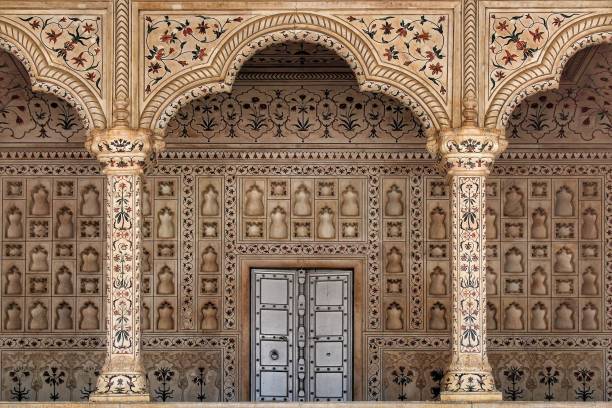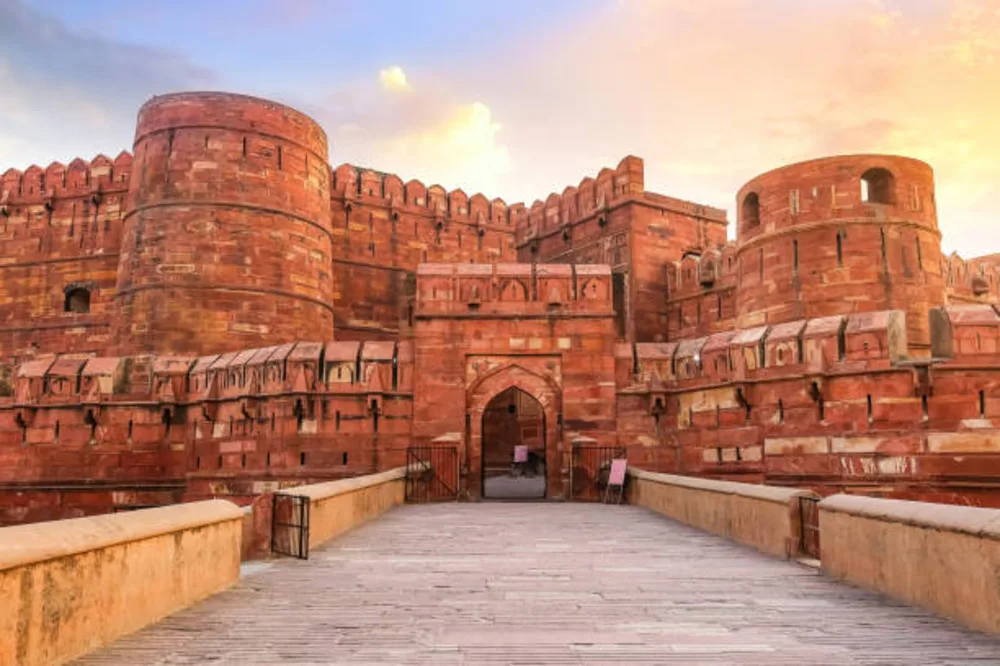Agra, a city that has charmed travelers for centuries, is not only home to the majestic Taj Mahal but also to another architectural gem — the Agra Fort. Often overshadowed by the Taj Mahal, Agra Fort is a spectacular example of Mughal architecture, representing the artistry and grandeur of a bygone era. In this blog, we’ll explore how Agra Fort stands tall as a testament to the brilliance of Agra architecture. From its history to architectural features, we will delve deep into the marvels of this UNESCO World Heritage Site.
Let’s embark on a journey to discover the intricate designs, historical importance, and why this fort should be on every traveler’s itinerary.
A Glimpse Into the Rich History of Agra Fort: Unveiling the Marvels of Agra Architecture
Agra Fort, also known as the Red Fort of Agra, is more than just a military structure; it’s a monumental work of Agra architecture. The fort was originally built in the 11th century by the Chauhan Rajputs, but the current structure took shape under the reign of Emperor Akbar in 1565. Constructed primarily out of red sandstone, Agra Fort stands as a remarkable example of Mughal architecture, combining both defensive and aesthetic elements.
Its significance extends beyond its beauty. Agra Fort was the seat of Mughal power for generations, where emperors like Akbar, Jahangir, Shah Jahan, and Aurangzeb lived and ruled the empire. From the halls of this fort, the Mughal Empire commanded a vast territory, making it not only a marvel of Agra architecture but also a pivotal location in Indian history.
Agra Architecture at Its Finest: A Tour Inside the Agra Fort

Agra Fort is a vast complex, spread over 94 acres, and is surrounded by thick walls rising up to 70 feet. The fort houses several structures within, each showcasing a unique aspect of Agra architecture.
Let’s take a closer look at some of the most magnificent structures inside Agra Fort:
| Structure Name | Architectural Highlights | Significance in Agra Architecture |
| Diwan-i-Aam | A hall with elegant arches and pillars. | Used for public audience by the emperor. |
| Diwan-i-Khas | Built in white marble with intricate carvings. | Private audience hall for the emperor to meet important guests. |
| Moti Masjid | A mosque made entirely of white marble. | Known as the Pearl Mosque for its stunning beauty. |
| Jahangiri Mahal | A blend of Hindu and Islamic architectural styles. | Residence of the royal women, showcasing ornate designs. |
| Musamman Burj | A luxurious tower with views of the Taj Mahal. | The place where Shah Jahan was imprisoned by Aurangzeb. |
| Sheesh Mahal | Decorated with thousands of tiny mirrors. | Used as a royal dressing room, a stunning example of artistry. |
| Anguri Bagh | A beautiful garden with geometrically aligned flowerbeds. | Adds to the aesthetic appeal, highlighting Mughal landscaping. |
| Khas Mahal | A palace with finely carved marble walls and floral designs. | Built as a luxurious residence for Emperor Shah Jahan, reflecting the Mughal style of royal living. |
| Nagina Masjid | A private mosque for the royal women, made from pure white marble. | Symbolizes the beauty of Islamic religious architecture within Agra Fort. |
| Hammam (Royal Baths) | A series of elaborately designed bathing chambers, complete with intricate frescoes. | Showcases the luxurious lifestyle of the Mughal rulers and the advancements in architectural hygiene. |
Each of these structures represents the richness of Agra architecture, where function meets form in the most spectacular ways. The intricate carvings, the use of marble and sandstone, and the grand scale of construction are all hallmarks of the architectural brilliance of the Mughals.
The Strategic Importance of Agra Fort
Agra Fort wasn’t just a residence for royalty—it also played a critical military role. Its design, while stunning, also focused on defense. The fort’s walls are built with red sandstone and are extremely thick, providing protection against enemy attacks. There are four massive gates, the most famous being the Amar Singh Gate, which is the primary entrance for tourists today.
The design of Agra Fort was so impressive that it was used as a blueprint for later forts in India, making it a key part of the evolution of Indian fort architecture.
Why Agra Fort is a Must-Visit for Architecture Lovers
- A Blend of Styles: Agra architecture is characterized by a unique blend of Persian, Islamic, and Hindu styles. This can be seen in the intricate latticework, arches, domes, and minarets throughout the fort.
- Innovative Use of Materials: The use of both red sandstone and white marble highlights the Mughal’s innovative approach to construction. The Diwan-i-Khas and Moti Masjid, made entirely of white marble, provide a striking contrast to the red sandstone used elsewhere in the fort.
- A Showcase of Mughal Luxury: Structures like the Sheesh Mahal and Musamman Burj were designed with comfort and beauty in mind. These buildings feature ornate decorations, mirrored ceilings, and luxurious living spaces, emphasizing the opulence of Mughal rulers.
- Perfect View of the Taj Mahal: The Musamman Burj offers a breathtaking view of the Taj Mahal, which adds another layer of allure to this already stunning example of Agra architecture. It’s a poignant reminder of Shah Jahan’s imprisonment in this very tower, where he spent his last days gazing at the monument he built in memory of his beloved wife.
Architectural Innovations in Agra Fort
The design of Agra Fort also introduced several innovations that influenced future structures in India:
- Advanced Water Systems: The fort was equipped with an advanced water supply and drainage system, showcasing the Mughal’s engineering prowess.
- Cooling Mechanisms: The Sheesh Mahal was designed to stay cool even in the scorching heat of Agra’s summers, thanks to the reflective mirrors and the ventilation system.
- Symbolic Designs: Much of the fort’s design incorporates symbolic elements, such as the lotus motif and the use of Persian verses in the carvings.
These innovations highlight how Agra architecture was not just about aesthetics but also about functionality and comfort.
Also Read: Unraveling the Magical Tapestry of Uttar Pradesh
Conclusion
With the addition of Khas Mahal, Nagina Masjid, and the Hammam, the Agra Fort’s already impressive array of structures becomes even more breathtaking. These architectural marvels, each with its unique purpose and style, highlight the versatility and brilliance of Agra architecture.
From lavish palaces to serene mosques and innovative bathhouses, Agra Fort stands as a testament to the Mughal’s passion for creating not just functional buildings but works of art that have withstood the test of time. Each structure within the fort adds depth to the historical and architectural narrative, making Agra Fort a must-visit for anyone interested in exploring the rich legacy of India’s past.
Agra Fort offers visitors the chance to step back in time and experience the grandeur of the Mughal Empire through the lens of its most stunning architectural achievements.
If you’re an architecture enthusiast or a traveler looking for a deeper connection with India’s history, Agra Fort is the place where you can witness the splendor of Agra architecture in its full glory.
Explore More on Xplro.com
Discover more architectural wonders in Agra and beyond with Xplro.com. Whether you’re intrigued by India’s rich history or want to delve into the intricate designs of ancient monuments, we’ve got the perfect guides for you. Explore the best destinations, travel itineraries, and hidden gems that will make your journey unforgettable.






